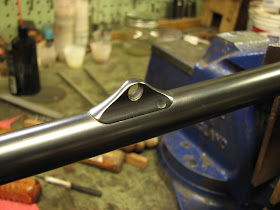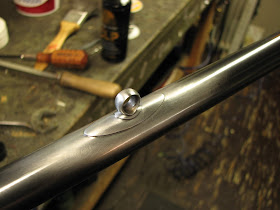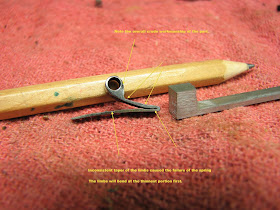In the interest of full disclosure, the following will be a rant. Parts of it may be amusing, but still a rant, none the less. It might even serve the purpose of clarifying a few things, so here goes.
Sometimes people ask things that just make me shake my head, other times, they ask things that make me think that my head is going to explode. I'd like to think that most of the time there is no ill will intended, but sometimes.....
To wit:
So, What Do You Actually Do?
A.k.a., What's your "real job"?
This one is really a head scratcher. Perhaps it has its roots in the number of hack dabblers that have taken their crimes against craftsmanship to the next level by getting an FFL, hanging out a shingle and "going pro" when they should concentrate on their day jobs.
My business is my livelihood and my sole source of income. I do not
have a stock portfolio, I do not collect a pension from a prior real
job and my wife does not have a "sweet gig" that allows me to "play
gunsmith".
Please note: The above is in no way an indictment of the serious, and seriously talented, hobbyists out there. Many of those guys could teach the "pros" a thing or two.
Who Does Your _________?
For the billionth time, I DO NOT FARM OUT WORK. If I offer a service, I'm the one who does it, period. It's insulting and it clearly means that you assume that I could not have done whatever it is you're asking about. Maybe I should answer this question with one of my own, like: "Who f**ks your wife?"
But He's a Master Gunsmith.
No, the person who bodged up your gun is not a "master gunsmith". There are NO "master" gunsmiths in America precisely because there is no guild or apprenticeship system in America to create apprentices, who then go on to become journeymen, and then finally, masters. Anyone who presents himself as a "master gunsmith" should be viewed with as much suspicion as one can muster because he's the one who gave himself that title. There is at least one gunsmithing school that actually awards a "master" diploma, for completing a
16-month course. One and a half whole years of "school", truly, they must be masters. I could go on and on about gunsmithing schools in this country, but It's too depressing.
But He's an English-Trained Gunsmith.
A British accent is no guarantee of competence, nor of honesty. Why gun people go all gooey over a Brit accent is a bit of a mystery to me.
Who Would You Recommend To _____________?
I get this one a lot. Why someone would call or e-mail a gunsmith and ask them to recommend a gunsmith is a bit baffling to me. It seems a bit like asking your dentist if he knows a good dentist.
It's rude, don't do it.
Can You Tell Me How To ______________?
When people e-mail me or call me on the phone asking how to do something
(usually very specific), it can only be seen as a minor miracle that my
f*****g head doesn't explode. Do these people call a lawyer asking for
free advice? How about calling the car dealership and asking how to
fix your car? Call a plumber and ask him to literally talk you through
replacing the water heater? I didn't think so, but for some reason
there are some people who own guns that think that's okay to do. They
go on forums and spout off about socialism and other political nonsense, but when they
need information about working on a gun, they suddenly turn into a
pretty good imitation of "socialists", meaning they want free stuff, in
this case, information. The internet seems to have made everyone
believe that "mere information" should be free, for all (community and all that). Well then, go
to the internet gun forums if you want free information, it will usually be
worth exactly what you pay for it.
Can You Give Me a Quote?
No. I can give you a rough idea of the cost but, until I get inside the gun, I won't know the extent of a problem, nor can I know what previous "gunsmithing" needs to be corrected. Most old guns have been worked on at some point in their existence and that work varies widely in quality.
That Seems Awfully Expensive.
What is your frame of reference to have any opinion, at all, as to what something as esoteric as this kind of work
should cost? You're paying for skilled labor that, literally, a handful of people in this country are capable of performing. This is not flat-rate wrench-slinging at the Chevy dealership. I won't even get into how many hours that
I don't bill for just because I want anything that I do to be as good as I can do it.
I'm also pretty sure that most good plumbers charge more per hour than I do.
So and So said he could do it for this much.
Then take it to them. I'm not a hack and, as they say, you get what you pay for.
But I've Already Got _________ Dollars In It.
To be blunt, I don't care. What you paid for the gun has zero effect upon the value of my time, which is non-negotiable.
What Can You Do For ______ Dollars?
Nothing. I do not, and never will, work down to a price. I would either have to do the entire job for your price, at lower quality, OR, I stop work once I've hit your dollar limit. I choose neither.
Can I Have It By ________?
See here:
https://vicknairgunsmithing.blogspot.com/2017/09/gunmaker-math.html












